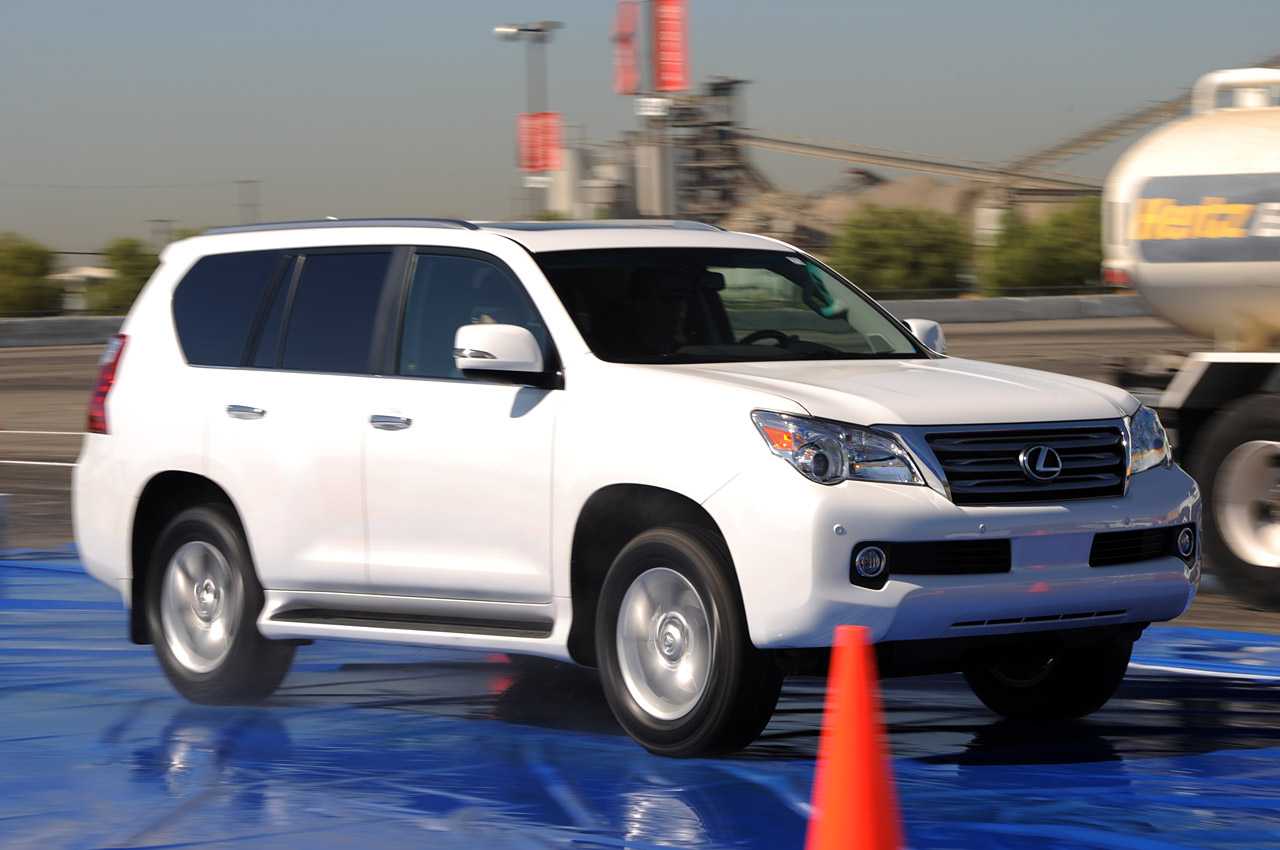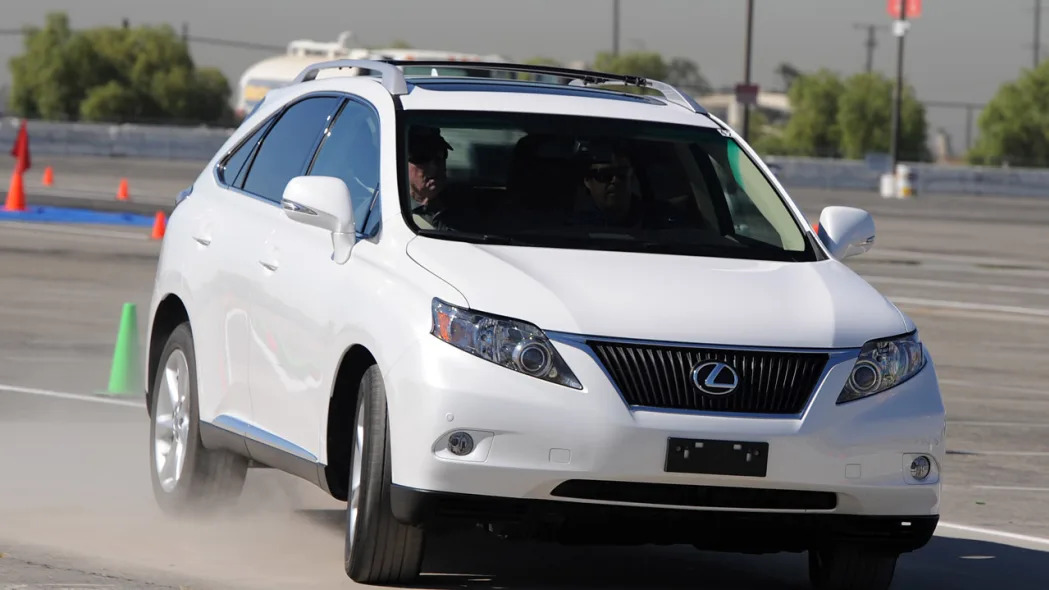Lexus Safety Experience – Click above for high-res image gallery
You're an auto enthusiast. You know what all the acronyms on the buttons around your dash stand for. You understand that braking power can beat engine power 99% of the time. That feeling you get from activating the anti-lock braking system? It's not "scary" and you know you should keep your foot down. The problem is that the average driver or new-car shopper is not an enthusiast. Lexus knows this and it has created an event to help educate its salesmen around the country, who in turn can better explain the safety systems available on the cars in the showroom.
The Lexus Safety Experience is a half-day event that highlights the safety tech fitted to most Lexus vehicles (some 2010 models and all 2011s). In short, it decodes the aforementioned acronym alphabet soup and then demonstrates exactly what each one does. What does VSC stand for? What is TRAC and VDIM? Is EBD something I should get tested for?
Answers: Vehicle Stability Control. Traction Control Activity Area and Vehicle Dynamics Integrated Management. No, it means Electronic Brake-Force Distribution.
The terms might be foreign concepts to many of its customers, but Lexus is trying to change that. Not by telling its sales force what everything means – by showing them.
Photos by Drew Phillips/Copyright 2010 ©2010 Weblogs, Inc.
 The day starts with an explanation of Lexus' commitment to safety and a discussion on ways the company is improving its already excellent craftsmanship. Lexus has teamed up with NASA and the Academy of Science to continually refine its safety technology and testing procedures. Its already at work on the production of the next generation of crash test dummy, which can simulate internal organ damage. Lexus will license this technology to other automakers and institutions. Currently, its vehicle testing is tops in the industry but Lexus is looking how to make it better.
The day starts with an explanation of Lexus' commitment to safety and a discussion on ways the company is improving its already excellent craftsmanship. Lexus has teamed up with NASA and the Academy of Science to continually refine its safety technology and testing procedures. Its already at work on the production of the next generation of crash test dummy, which can simulate internal organ damage. Lexus will license this technology to other automakers and institutions. Currently, its vehicle testing is tops in the industry but Lexus is looking how to make it better.
Too much talking makes drivers and journalists antsy, but it was soon time to get behind the wheels of someone else's luxury automobile. Lexus broke up the driving portion of the event into three courses; Anti-lock braking, Stability/Traction and Smart-Stop.
First up, we jumped into the seat of a Lexus RX 350 which had its ABS system unplugged. The instructor told us to give it full boot and then go hard on the brakes at his command. We would then try and merge hard to the right to avoid a line of cones. To make it tougher, our braking area was littered with sand. As you would imagine, going hard on the brakes without ABS meant we became a fast-moving sled. There was no chance to make it to the right the crossover would've become a pile of bent metal were there cars in front of us. Next time around the course, we were given the same instructions but this time in an RX 350 with ABS working as it should. The result? Some braking wizardry underfoot and we could still control the car. In fact, no cones were harmed in getting our Lexus safely in the new lane. Anti-lock braking systems are your friend, but many people simply don't understand what they are feeling when they engage it. This is a great chance to understand that the pedal feel and strange noises are supposed to be happening and might just save your life.

Moving over to the Stability and Traction course, we hopped into a Lexus GX 460. The course features a quick wet zone, followed by a dry straight leading into a tight left-hand turn. First up, we ran through the course with traction and stability control turned off. On the wet pad, we floored it and listened to the familiar sound of a revving engine going nowhere fast. After that, we moved down the straight at speeds up to 27 miles per hour before trying to make the left-hand turn. The folks at Lexus thought this was a good place to put some more sand and our GX 460 thought it was a good idea to make for the far right cones. We didn't him them, but you could have fit a studio apartment in between our intended line and where we actually went. Next time around, we did the same thing but with traction and stability control enabled. As you can probably guess, it was a very different affair. The SUV came right around while flashing lights on the dash showed that things were happening underneath the vehicle.
Those "things" include the Traction Control system applying slight brake pressure to reduce the speed of wheels that are spinning while transferring torque to wheels that have grip. It also includes the Vehicle Stability Control system monitoring vehicle speed, cornering motion, yaw rate and steering angle. The VSC can then determine if the car is neutral, understeering or oversteering and correct if necessary. The speed of 27 miles per hour was determined to be the right speed for this specific corner – any less and we probably wouldn't get the systems to react, any more and we might be writing off an expensive luxury SUV. That speed was determined by Roberto Guerrero who was brought in to help setup the event, and is a man who knows what he's talking about.

After making text-message style lane changes with ABS and trying to tip over a Lexus GX 460, it was time to move to the last course – the Smart-Stop station. This exercise was the most interesting of the three and it provided a real eye opening moment for a lot of people. We all know that Toyota has been in the news for claims of unintended acceleration. This technology helps to quell any fears people may have of such an occurrence. Smart-Stop technology is essentially a brake override system; when engaged, it automatically reduces engine power when the brake and gas pedal are applied simultaneously. It can only engage when the throttle opening is greater than one-third, the vehicle speed is above 5 miles per hour and the brakes are applied firmly.
For this loop, we jumped into a Lexus ES 350 equipped with the new Smart-Stop feature. Our instructions were to floor it, wait for the instructor to tell us to brake, then keep the accelerator floored while mashing and holding the brakes. The result? The car stops. Quickly. To further demonstrate the effectiveness of this system, we do the same thing but in a Lexus IS 250 that doesn't have the Smart-Stop tech. We again came to a stop, just a bit further down the track. This is a system that is fitted to all 2011 Lexus vehicles and can provide some piece of mind to anyone worried about their throttle getting stuck open.
All three courses are great tools that provide a real-life sensation of how these safety systems work. Some of this stuff is common knowledge for the automotive enthusiast. We know that brake power will beat engine power 99 percent of the time. We understand that you can pop the car into neutral without harming your engine or transmission if your throttle were to get stuck. The idea of independently braking wheels while moving torque around is not groundbreaking to us. You know what, though? These concepts are foreign to a lot of the car-buying public.
During the Lexus Safety Experience we were teamed up with another driver, a mommy blogger to be precise. She was friendly, smart and asked some great questions – and she had no clue what was going on with the vehicles we were driving. It was actually very interesting to be a passenger for her driving stints because we sometimes forget that not everyone understands all this tech or even what we perceive to be relatively common automotive knowledge. This program opened her eyes and she walked away a better driver because of it.
Lexus is currently offering this program as means to educate its sales staff, who in turn can educate consumers. The problem is that the message might get lost in translation and nothing teaches like experience. This is a service that would work far better if they put consumers behind the wheel and had them experience what we did.
A better understanding of what keeps us safe can only make us safer, right?



Sign in to post
Please sign in to leave a comment.
Continue